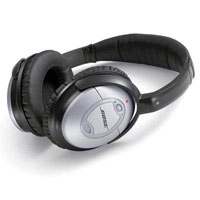Bose was the first company to introduce noise-canceling headphones.
Photo courtesy
Unfortunately for music lovers, many types of ambient sounds can interfere with or even block the sounds coming through their headphones. If you have ever tried to listen to a CD or MP3 player on a plane, then you know the problem well: The roar of the engines makes it difficult to hear what's being piped through the speakers -- even when those speakers are situated in or on your ear. Fortunately, noise-canceling headphones can provide a more enjoyable listening experience.
Noise-canceling headphones come in either
Active
If you look at the illustration below, you can see how this works. Notice that the two waves -- the one coming from the noise-canceling headphone and the one associated with the ambient noise -- have the same amplitude and frequency, but their crests and troughs (compressions and rarefactions) are arranged so that the crests (compressions) of one wave line up with the troughs (rarefactions) of the other wave and vice versa. In essence, the two waves cancel each other out, a phenomenon known as

Of course, several components are required to achieve this effect:
- Microphone
- A microphone placed inside the ear cup "listens" to external sounds that cannot be blocked passively. - Noise-canceling circuitry
- Electronics, also placed in the ear cup, sense the input from the microphone and generate a "fingerprint" of the noise, noting the frequency and amplitude of the incoming wave. Then they create a new wave that is 180 degrees out of phase with the waves associated with the noise. - Speaker
- The "anti-sound" created by the noise-canceling circuitry is fed into the headphones' speakers along with the normal audio; the anti-sound erases the noise by destructive interference, but does not affect the desired sound waves in the normal audio. - Battery
- The term "active" refers to the fact that energy must be added to the system to produce the noise-canceling effect. The source of that energy is a rechargeable battery.
Using these components, noise-canceling headphones are able to provide an additional reduction in noise of 20 decibels. That means about 70 percent of ambient noise is effectively blocked, making noise-canceling headphones ideal for airline and train travel, open office environments or any other location with a high level of background noise.
While noise-canceling headphones do a good job distinguishing between the audio a wearer wants to hear and the background noise he or she wants to keep out, some people say that they compromise sound quality by muffling sounds. Users can also experience a change in air pressure, although ports built into the ear cup are meant to vent air trapped behind the speakers.
In spite of these tradeoffs, many people would never go back to normal audio headphones. That's because noise-canceling headphones do more than reduce noise. They also help alleviate fatigue when traveling, which can result from exposure to low-frequency noise for an extended period of time. You can even use noise-canceling headphones if you don't want to listen to another audio source but do want to cancel out background noise. And a little bit of quiet can be music to anyone's ears.
For lots more information on noise-canceling headphones and related topics, check out the links on the next page.
A
When a headphone is equipped with a small microphone, it is called a
(Source: How stuff works?)



